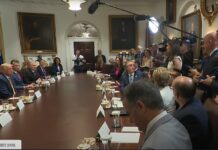Ukraine’s on again/off again relationship with the United States appears to be back on again with the signing of a long-awaited deal that will see profits from the future sale of Ukraine’s mineral and energy reserves shared between the two countries.
Following a meeting between Ukrainian President Volodymyr Zelenskyy and US President Donald Trump at the funeral of Pope Francis in Vatican City on 26 April 2025, the mineral deal was signed in Washington, DC, on 30 April by Ukraine’s economy minister, Yulia Svyrydenko, and US Treasury Secretary Scott Bessent.
The deal seemed to show a change in attitude from Trump, who had previously appeared to serve as an apologist for the belligerence of Russian President Vladimir Putin regarding the Ukraine War and who had engaged Zelenskyy in a combative meeting in Washington on 28 February. Following that meeting, on the evening of 3 March, Trump had ordered a suspension of US military aid to Ukraine, accusing the Ukrainian president of not accepting Trump-led diplomacy as the best path to a truce in the Ukraine War.
After his meeting with Zelenskyy inside St Peter’s Basilica, however, in the wake of a Russian missile barrage on Ukrainian population centres, Trump posted on social media, “There was no reason for Putin to be shooting missiles into civilian areas, in cities and towns, over the last few days. It makes me think that maybe he doesn’t want to stop the war. He’s just tapping me along.”
The Agreement on the Establishment of a United States–Ukraine Reconstruction Investment Fund, as it is officially known, thus has significant symbolic meaning, but it also delivers multiple concrete measures conducive to both Kyiv’s and Washington’s objectives.
Most immediately, the deal has facilitated the go-ahead for roughly USD 50 million (EUR 44.3 million) of defence-related products to be exported through direct commercial sales (DCS) to Kyiv. This is not a large amount in the whole scheme of things, but it breaks the 3 March suspension of US military products flowing to Kyiv.
It also appears that the Trump Administration has dropped its previous demand that Ukraine pay back any supposed debt from the more than USD 65 billion in US military aid previously provided to the country.
The US Treasury Department also stated that the minerals deal had been reached “in recognition of the significant financial and material support that the people of the United States have provided to the defence of Ukraine since Russia’s full-scale invasion” – an acknowledgement of Russian belligerence that will be most welcome in Kyiv.
The text of the agreement also makes clear that the US acknowledges Ukraine’s intention to join the EU and that the agreement does not conflict with that.
To get the deal over the line Ukraine dropped its key demand that the United States provide security guarantees as part of the agreement. Beyond this, however, and given that Trump continues to see international relations in a purely ‘business transactional’ context, the minerals deal – which also includes provisions for oil, natural gas and other hydrocarbons – also lays out how Ukraine will effectively pay for continued US military support. This contrasts with the previous Biden Administration, which had simply seen Ukrainian resistance to Russia’s invasion of Ukraine in February 2022 as an existential struggle against Putin’s military expansionism that required no provisos to be offered.
The US-Ukraine minerals deal will establish a US-Ukraine Reconstruction Investment Fund, with each side having equal voting rights, that the Trump administration has said will begin to repay what it claims is an estimated USD 175 billion in aid provided to Ukraine since the beginning of the war. The deal will exclusively finance mineral, oil and gas projects as well as infrastructure and processing in Ukraine, with profits fully reinvested in Ukraine’s economy for the first decade. After that, the profits from the fund will be distributed equally between the US and Ukraine.
Bessent stated of the deal, “This agreement signals clearly to Russia that the Trump Administration is committed to a peace process centred on a free, sovereign and prosperous Ukraine over the long term.”
Only time will tell, of course, whether the US-Ukraine minerals deal heralds a true and positive resetting of relations between Washington and Kyiv. However, it does at least break an impasse that in February looked wholly intractable and which placed Ukraine in a considerably difficult position in its fight against Russia’s invasion.











